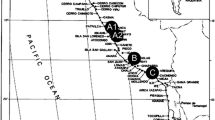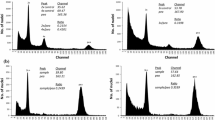Abstract
The breeding systems of 12 species and varieties of Trifolium from Africa were investigated. One annual and the three perennial species were allogamous and self-incompatible, the other annuals were autogamous.
The effect of temperature on pollen germination and growth was variable. In some species high temperatures (30°C) adversely affected pollen germination and low temperatures (20°C) in others. A high humidity (93–98% R.H.) was essential for good pollen germination and growth.
Approach grafts indicated that these species were closely related, however, this method of grafting may not be as reliable as the cleft graft for assessing species relations. From hybridization attempts between seven species, it appears that some interspecific hybrids may be possible within this group.
Similar content being viewed by others
References
Bogdan, A. V., 1956. Indigenous clovers of Kenya. E. Afr. Agric. J., 22: 40–45.
Bogdan, A. V., 1966. Pollination and breeding behaviour in the Trifolium rueppellianum complex in Kenya. New Phytol. 65: 417–422.
Britten, E. J., 1963. Chromosome numbers in the genus Trifolium. Cytologia 28: 428–449.
Evans, A. M., 1960. Relationship between vegetative and sexual compatibility in Trifolium. Welsh Plant Breeding Station Rep. 1959: 81–87.
Evans, A. M., 1962. Species hybridization in Trifolium. I. Methods of overcoming species incompatibility. Euphytica 11: 164–176.
Hutton, E. M., 1960. Flowering and pollination in Indigofera spicata, Phaseolus lathyroides, Desmodium uncinatum and some other tropical pasture legumes. Emp. J. Exp. Agric. 28: 235–243.
Hutton, E. M. and Peak, J. W., 1954. Studies of intervarietal hybridization in subterranean clover (Trifolium subterraneum). Aust. J. Agric. Res. 5: 271–278.
Keim, W. F., 1953. Interspecific hybridization in Trifolium utilizing embryo culture technique. Agron. J. 45: 601–606.
't Mannetje, L., 1964. The use of some African clovers as pasture legumes in Queensland. Aust. J. Exp. Agric. Anim. Husb. 4: 22–25.
Norris, D. O., 1959. Rhizobium affinities of African species of Trifolium. Emp. J. Exp. Agric. 27: 87–97.
Norris, D. O. and 't Mannetje, L., 1964. The symbiotic specialization of African Trifolium spp. in relation to their taxonomy and their agronomic use. E. Afr. Agric. J. 29: 214–235.
Pritchard, A. J., 1962. Number and morphology of chromosomes in African species in the genus Trifolium L. Aust. J. Agric. Res. 13: 1023–1029.
Strange, R., 1958. Preliminary trials of grasses and legumes under grazing. E. Afr. Agric. J. 24: 92–102.
Author information
Authors and Affiliations
Rights and permissions
About this article
Cite this article
Pritchard, A.J., t' Mannetje, L. The breeding systems and some interspecific relations of a number of African Trifolium spp.. Euphytica 16, 324–329 (1967). https://doi.org/10.1007/BF00028938
Received:
Issue Date:
DOI: https://doi.org/10.1007/BF00028938




